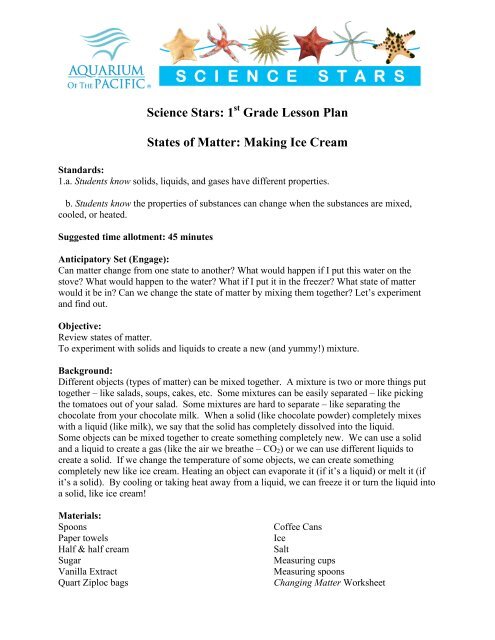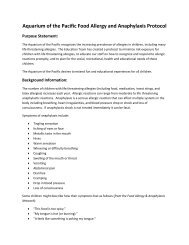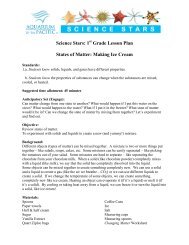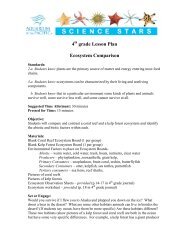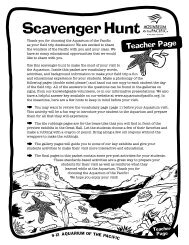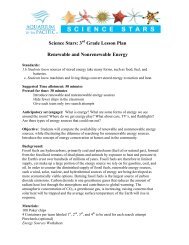Making Ice Cream - Aquarium of the Pacific
Making Ice Cream - Aquarium of the Pacific
Making Ice Cream - Aquarium of the Pacific
Create successful ePaper yourself
Turn your PDF publications into a flip-book with our unique Google optimized e-Paper software.
Science Stars: 1 st Grade Lesson Plan<br />
States <strong>of</strong> Matter: <strong>Making</strong> <strong>Ice</strong> <strong>Cream</strong><br />
Standards:<br />
1.a. Students know solids, liquids, and gases have different properties.<br />
b. Students know <strong>the</strong> properties <strong>of</strong> substances can change when <strong>the</strong> substances are mixed,<br />
cooled, or heated.<br />
Suggested time allotment: 45 minutes<br />
Anticipatory Set (Engage):<br />
Can matter change from one state to ano<strong>the</strong>r? What would happen if I put this water on <strong>the</strong><br />
stove? What would happen to <strong>the</strong> water? What if I put it in <strong>the</strong> freezer? What state <strong>of</strong> matter<br />
would it be in? Can we change <strong>the</strong> state <strong>of</strong> matter by mixing <strong>the</strong>m toge<strong>the</strong>r? Let’s experiment<br />
and find out.<br />
Objective:<br />
Review states <strong>of</strong> matter.<br />
To experiment with solids and liquids to create a new (and yummy!) mixture.<br />
Background:<br />
Different objects (types <strong>of</strong> matter) can be mixed toge<strong>the</strong>r. A mixture is two or more things put<br />
toge<strong>the</strong>r – like salads, soups, cakes, etc. Some mixtures can be easily separated – like picking<br />
<strong>the</strong> tomatoes out <strong>of</strong> your salad. Some mixtures are hard to separate – like separating <strong>the</strong><br />
chocolate from your chocolate milk. When a solid (like chocolate powder) completely mixes<br />
with a liquid (like milk), we say that <strong>the</strong> solid has completely dissolved into <strong>the</strong> liquid.<br />
Some objects can be mixed toge<strong>the</strong>r to create something completely new. We can use a solid<br />
and a liquid to create a gas (like <strong>the</strong> air we brea<strong>the</strong> – CO 2 ) or we can use different liquids to<br />
create a solid. If we change <strong>the</strong> temperature <strong>of</strong> some objects, we can create something<br />
completely new like ice cream. Heating an object can evaporate it (if it’s a liquid) or melt it (if<br />
it’s a solid). By cooling or taking heat away from a liquid, we can freeze it or turn <strong>the</strong> liquid into<br />
a solid, like ice cream!<br />
Materials:<br />
Spoons<br />
Paper towels<br />
Half & half cream<br />
Sugar<br />
Vanilla Extract<br />
Quart Ziploc bags<br />
C<strong>of</strong>fee Cans<br />
<strong>Ice</strong><br />
Salt<br />
Measuring cups<br />
Measuring spoons<br />
Changing Matter Worksheet
Prep:<br />
· Make sure no one is allergic to <strong>the</strong> ingredients.<br />
· Each student (or group) will make <strong>the</strong>ir own bag <strong>of</strong> ice cream; <strong>the</strong>refore,<br />
ingredients need to be measured and prepared ahead <strong>of</strong> time.<br />
· Each student )group will receive:<br />
o ½ cup cream<br />
o 1 tbsp sugar<br />
o 1 tsp vanilla extract<br />
o 1 quart Ziploc bag<br />
o C<strong>of</strong>fee can filled with 2<br />
cups ice<br />
o ¼ cup salt<br />
o 1 spoon<br />
Vocabulary:<br />
· Solid<br />
· Liquid<br />
· Gas<br />
· Matter<br />
· Observation<br />
· Mixture<br />
Modeling:<br />
Review <strong>the</strong> terms matter. Have students give examples <strong>of</strong> each type <strong>of</strong> matter using <strong>the</strong><br />
terms solid, liquid, and gas. Explain that, in this lesson, we will take <strong>the</strong> different states<br />
<strong>of</strong> matter we learned about and combine <strong>the</strong>m to make something new –ice cream!<br />
Guided Practice:<br />
· Set out ingredients to make ice cream: cream, sugar, vanilla, ice and salt.<br />
· Have students describe each ingredient as a solid, liquid, or gas.<br />
· For each ingredient, have students complete a box on <strong>the</strong> Creating Matter<br />
worksheets.<br />
Modeling:<br />
Demonstrate how to combine <strong>the</strong> ingredients and set <strong>of</strong> <strong>the</strong> experiment. Once all students<br />
have materials, help <strong>the</strong>m tightly close <strong>the</strong> bag to avoid spills.<br />
Guided Practice:<br />
· Mix ½ cup cream, 1 tbsp sugar and 1 tsp vanilla into a small Ziploc bag.<br />
· Squeeze out extra air and zip <strong>the</strong> bag closed. Set this bag aside.<br />
· Add ¼ cup salt to c<strong>of</strong>fee can filled with ice.<br />
· Place small bag inside <strong>the</strong> c<strong>of</strong>fee can and seal <strong>the</strong> can tightly.<br />
· Shake <strong>the</strong> can for 10 minutes.<br />
· Remove <strong>the</strong> small bag and observe whe<strong>the</strong>r <strong>the</strong> ice cream is a solid or a liquid.<br />
· Open <strong>the</strong> small bag and use <strong>the</strong> spoon to enjoy <strong>the</strong> ice cream!
Check for understanding:<br />
What state <strong>of</strong> matter is ice cream? (solid) What did we use to make it? (milk and vanilla –<br />
liquids and sugar and ice – a solid) What did we take away to change from liquid to<br />
solid? (took away heat with ice)
Cold, slippery, wet<br />
Clear, square<br />
Small, like sand, hard<br />
Tastes good, white
Wet, cold, white<br />
Tasty<br />
Smells good, brown<br />
Yummy! White, small<br />
Looks like salt


